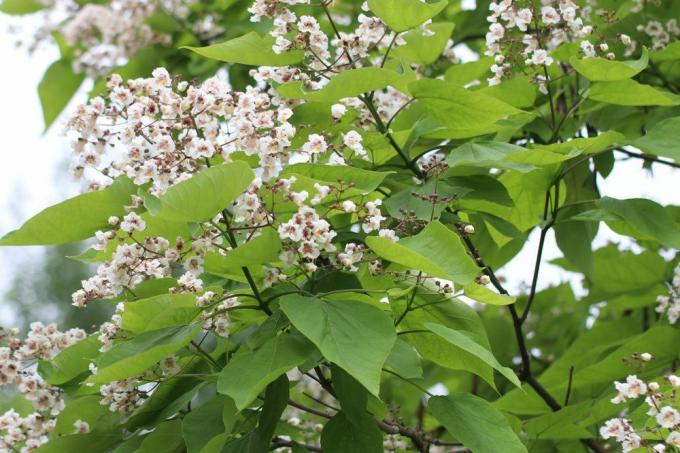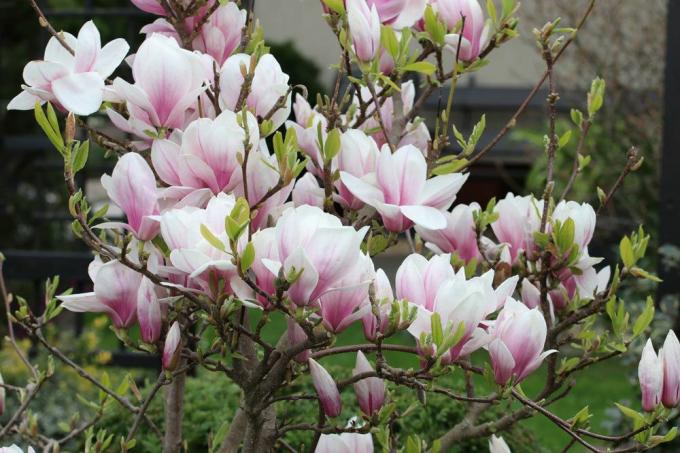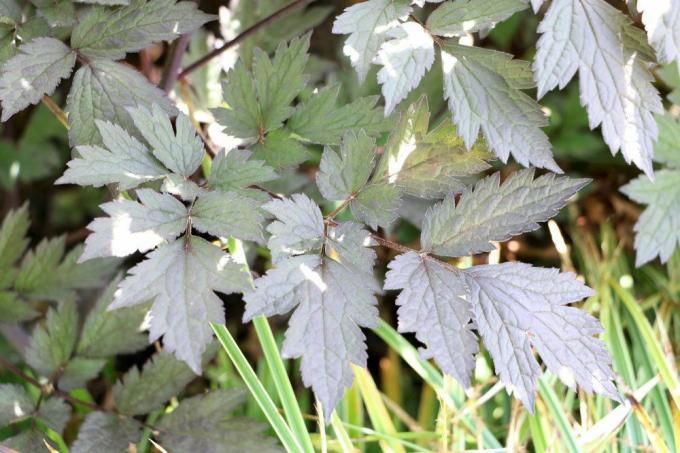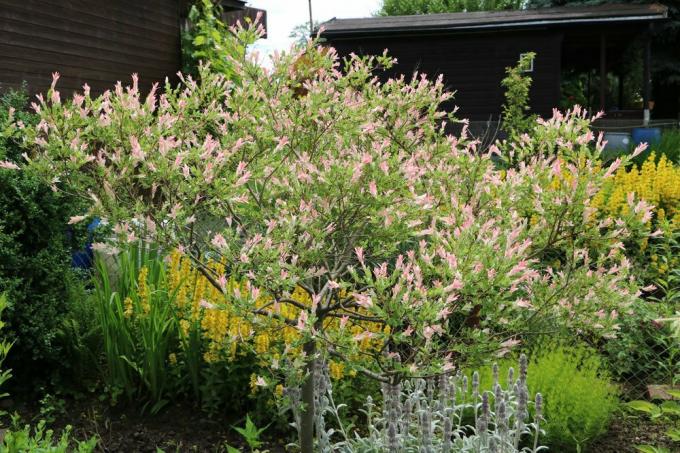
table of contents
- Shadow areas
- Tree species
- Spherical crowns
- Flowering trees
- Shade tolerant trees
- Evergreen trees
Permanently greening shady areas is always associated with the difficulty of finding suitable plants. Trees are no exception, because very few woody plants really love shade over the long term. Although many of them are more shade-tolerant in their youth, with increasing age the trees strive towards the light. Still, there are some species or varieties of trees that can be described as shade tolerant.
Shadow areas
No plant is permanently suitable for dark places. Trees also absolutely need one or the other light moment a day. It does not matter whether the light hits the trees at regular or irregular intervals. Not every shady area is created equal. This is why it is important to take a closer look at the space before deciding on a tree.
Penumbra
If a bed or an area in the garden is in the sun for at least four hours during the day and the rest of the area in the shade, it is called partial shade. With the exception of the special sun worshipers, almost all tree species grow here without any problems and you are spoiled for choice.

Light shade
Places under translucent trees and other elements that allow scattered light to pass through, or a constant alternation between light and shadow times is called light shadow. The lighting conditions here are similar to those in partial shade, only not separated by time of day. If trees are to be planted under tall, shallow-rooted trees, then the shade is usually not the problem. Usually they are troubled by the competition for roots and the nutrient-poor, possibly dry soil.
Full shade
Fully shaded places are somewhat problematic for permanent greening. Fortunately, they are very rare in the home garden. They are usually found under thick conifers or in small courtyards within very tall buildings. In the latter case, the plants still receive a little light from above, so that it is not as pitch black as in a dense coniferous forest.
Home garden
Shrubs and trees give a garden structure and inspire with shape, foliage or even flowers. However, the trees need to be selected very carefully so that they remain a beautiful eye-catcher in the long term and do not become the dominant element in a short time. That is why trees or bushes that remain small are mainly suitable for home gardens. Many front gardens also have the unfavorable property that they are on the north side of the house and therefore in shady areas. A rather inconvenient place in the garden for plants. Sometimes it is desirable that there is also some privacy protection, especially from the view from above. When planting, it is essential to keep the necessary distances to the house and water and sewage pipes.

Courtyard garden
In the inner-city area there are a large number of backyards where no large trees can be planted because it is already quite dark. Most of the smaller tree species need a lot of sun and are therefore not suitable for courtyard gardens with little light. Nevertheless, the residents do not have to do without a beautiful tree in the courtyard. There are also a number of trees that are more shade-tolerant than others.
Tree species
Tree species for the shade
With the so-called shade tree species, a fraction of the sunlight is sufficient for them to grow and thrive healthily. Therefore, in contrast to the light tree species, planting in the shadow area of houses and walls as well as under larger trees is possible. The distinct shadewood species found in our forests include beech, linden, yew and various types of maple. However, these trees reach enormous heights and are therefore not suitable for the home garden in their original form. However, there are also varieties or cultivated forms that remain smaller.
Spherical crowns
Trees with spherical crowns
Trees with spherical crowns that remain small and tall trunks are a particularly decorative design element for the front yard. Most front yard owners have to get by with little space. Nevertheless, you don't have to do without a beautiful tree with a spherical crown. The latest generation of these small trees is very easy to care for, as the crowns do not require regular pruning and they stay in good shape without extensive care. The following varieties are suitable for the shady north side.
Globe maple (Acer platanoides 'Globosum')
This tree species is one of the most interesting tree species for the less sun-drenched front yard. The spherical maple is a popular nesting site for birds and develops a spherical, very dense crown that widens slightly with age. If the tree is to be kept slim, it is advisable to cut it in early winter.
- partial shade to light shade
- Height: 3-4.5 m
- yellowish flowers in spring
- intense yellow color of the leaves in autumn
- summer green

Ball trumpet tree (Catalpa bignonioides 'Nana')
The ball trumpet tree forms a very dense crown of large leaves reminiscent of elephant ears. The tree grows very slowly and is not particularly tall, so it is suitable for the smallest front gardens. Young trees can still be a bit sensitive to frost. With increasing age, however, the ball trumpet tree becomes more and more frost-resistant. Cuts are possible, but not common.
- partial shade to light shade
- Height: 2-3 m
- normal garden soil, well-drained and rich in nutrients
- Autumn color of the leaves: yellow
- summer green

Flowering trees
Blooming trees for the shade area
Some trees are not only more shade-tolerant than others, but also produce attractive flowers. However, these trees bloom less, the darker their location is. So if you are looking for a flowering tree for a place on the north side of the house, you are on the safe side with the following trees:
Rock pear (Amelanchier)
The different types of rock pear grow naturally as a small tree or larger shrub. Although the rock pear thrives best in the sun or partial shade, the robust plant does not mind a more shady location. However, this should not be too moist, as the rock pear would otherwise be susceptible to powdery mildew.
- Height: 2-3 m
- Growth rate: around 30 cm per year
- Flower: white (April)
- Soil: loose and not too moist
- beautiful autumn colors in shades of orange
- Location: sunny to shady

Honeysuckle (Lonicera ledebourii)
The California honeysuckle is a real all-rounder under the trees. It tolerates dryness as well as wetness, the sun as well as the shade. But that's not all: it is frost-hardy, abundantly blooming and also windproof. There are varieties that grow as irregular shrubs, standard trunks or sparsely branched, tree-like varieties.
- Growth height: mostly 2-3 m
- Flowers: strong yellow or red in June / July
- almost all garden soils
- Location: sunny to shady

Cornelian cherry (Cornus mas and Cornus sanguinea)
The Cornelian cherry grows as a large shrub mostly with several emerging branches, rarely as a small tree up to heights between three and five meters. Particularly interesting are their golden yellow flowers, which appear on the wood before the leaves shoot in March or April. Their edible fruits are similar to cherries and are dark red in color.
- Height: 3-5 m
- Flowers: golden yellow (March / April)
- Fruits: cherry-like, edible
- fresh loam and humus soils, lime-loving
- Location: sunny to shady

Magnolia (Magnolia)
Magnolias are among the oldest decorative woods and are not only used in parks and avenues, but increasingly also in domestic gardens. The trees are much more shade-tolerant than other flowering tree species. From around the age of five, the trees form their flowers before the leaves shoot in spring. Magnolias grow very slowly and reach heights of three to four meters when they are old. But there are also shrub-like varieties that hardly grow higher than two meters.
- Tulip magnolia (Magnolia soulangiana): large pink-red flowers
- Magnolia 'Black Tulip': rarity from New Zealand with a water-lily-shaped, purple-red flower
- Star magnolia (Magnolia stellata): small, shrub-like growth, star-shaped flowers
- Shallow root
- shade compatible
- needs enough space to develop well

Magnificent Bell (Enkianthus campanulatus)
The magnificent bell usually grows as a shrub, in old age tree-like with side branches protruding in levels. The bluish-green leaves turn reddish to yellow in autumn. The peculiarity of the magnificent bell lies in its reddish-white flowers, which hang down from the shoots in a bell-shaped umbel. Since the wood is comfortable in places with less light, you can safely plant it in a front garden on the north side of the house.
- Height: 2-3 m
- Flowers: reddish-white, lily of the valley-like umbels in May / June
- for acidic soils
- Location: partially shaded to shady

Hawthorn (Crataegus laevigata)
The hawthorn owes its name to the carmine-red, double flowers that the small-crowned wood shines in May. Since the small tree or shrub can withstand heavy pruning, it is also suitable for smaller gardens and front gardens. He prefers to be in partial shade, but is also well tolerated by the shade. Uncut, the real hawthorn grows up to a height of six meters. It is also available as a high trunk with a slightly spreading crown.
- Growth height: up to a maximum of 6 meters
- well tolerated by cutting
- also available as low-growing standard stems
- As deep-rooters, they only need a little space in the ground
- can also be planted on paths or driveways
- Location: partial shade to light shade

Hawthorn (Crataegus)
This native large shrub or small tree can be recognized by its white flowers in May and the berries in late summer. The hawthorn not only tolerates almost all soils, but also locations in the shade. The hawthorn usually grows as a large, multi-stemmed shrub between three and five meters in height, but is very easy on pruning and, above all, extremely frost-resistant and wind-resistant.
- Height: up to 5 m
- white flowers in May and June
- pretty tough
- undemanding
- likes neutral or calcareous soils (no strongly acidic soils)
- orange autumn leaves

Shade tolerant trees
Trees that are shade-tolerant and have a special leaf color
In addition to flowers, the shape or color of the leaves can also be a very special ornament for trees or large shrubs. The following ornamental foliage trees are also suitable for shady locations, for example on the north side of the house:
Blood plum (Prunus blireana)
The blood plum does not develop any fruit after its beautiful pink bloom in spring. The plant prefers to be in a partially shaded location, but can also tolerate slightly more shady areas. There, however, the willingness to bloom decreases somewhat. Depending on the variety, the blood plum grows as a broad or rather narrow shrub or even as a spherical high stem, which, however, needs an occasional cut.
- Height: depending on the variety between 2 and 6 m
- Flower: pink in April to May
- Leaves: black-red to bronze-colored
- Soil: nutrient-rich, well-drained
- Location: partial shade

Harlequin Willow (Salix integra 'Hakuro Nishiki')
The harlequin willow, with its white and colorful dress of leaves, is an attractive eye-catcher in the garden, especially as a high trunk. Although the trees, which come from East Asia, only bloom with inconspicuous catkins, their unusual foliage color almost gives the impression of rich blossoms.
- Growth height: 1.5 to 3 m depending on the trunk height
- needs to be cut regularly
- Flowering: catkins in March / April
- white-green speckled, small-leaved foliage

Evergreen trees
A tree in the front yard can be an advantage or a disadvantage. That always depends on how much space is available and whether you prefer brightness in the house. Evergreen trees, especially in the front yard, offer good privacy protection from unwanted glances. If you don't want to plant sweeping trees in front of a window, you can fall back on narrow column shapes, which are available from many tree species. There are also trees that keep their dead leaves on the branches until spring and therefore provide good privacy all year round.
Pillar wood (Taxus baccata)
In addition to its columnar, slender growth, the columnar washer has other advantages. It grows very slowly and its dark green needles stay on the wood all year round, so that it is a feast for the eyes in the front yard even in winter. The female form of the columnar grapes forms fiery red, spherical berries, which are poisonous when consumed. If you have small children in the household, the male form without fruit set is better suited for you.
- dense, columnar growth
- Height: 4-7 m
- Soil: calcareous, nutrient-rich and moist
- Location: sunny to shady
- evergreen
- slowly growing
- also attractive in small groups

False cypress (Chamaecypraris lawsoniana)
The blue column cypress or also the yellow cone cypress show columnar growth. At heights between three and six meters, they remain quite narrow at 1.0 to 1.75 meters. If the evergreen plants are not to become too high, it is best to cut back the upper vegetation zone early on.
- Height: up to 6 m
- nutrient-rich, moist soils
- undemanding
- evergreen
- Location: sunny to shady

Hornbeam / White Beech (Carpinus betulus)
This low-growing beech species is known and popular, especially for hedges. But the native wild wood is also doing extremely well in isolation. What hardly anyone knows: the hornbeam or also the hornbeam can tolerate shade not only at a young age, but also in old age. The tree also provides excellent privacy, although it is not evergreen. But it keeps its dried up leaves until the rash in spring. Only when the new buds open are the old leaves shed. If the tree becomes too big, it can easily (even radically) be pruned and it will sprout again reliably.
- Height: up to 10 m
- very easy to cut
- nutrient-rich garden soils
- sunny to shady

